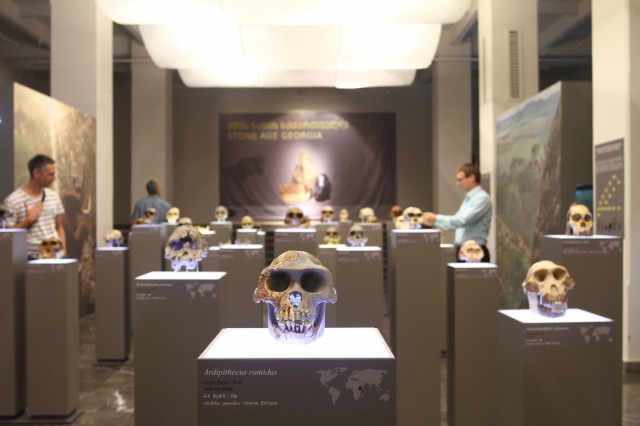Donald Johanson on Human Evolution in Tbilisi & his Discoveries
There are days of unexpected meetings that you instantly know you’ll remember many years ahead, if not forever. Today was that day for me… that evening, to be precise, where I was lucky enough to attend the pre-opening of the exhibition ‘Stone Age of Georgia’ at the Simon Janashia Museum in Tbilisi, and apart from a captivating exposition that strikes you with the age and magnitude of human history, I was able to grab Donald Johanson for an exclusive interview. Johanson is a famous American paleoanthropologist and the man behind numerous discoveries that have shaped our understanding of human history.
The exhibition opens to the public on September 27 and offers “a time flow of human evolution,” displaying the period of 1.77 million years in Georgia, starting with skulls found in Dmanisi (Kvemo Kartli) considered to be the oldest hominin fossils found in Eurasia and proving that the territory of Georgia was among the first locality of human dispersal out of Africa.
The exposition also showcases realistic reconstructions of early hominins and the Dmanisi paleoenvironment by world renowned paleoartists such as Elizabeth Daynes, John Gurche, Mauricio Anton and Rodolfo Nogueira.
The exhibition is to be held in the frames of the conference ‘100+25 years of Homo Erectus: Dmanisi and Beyond,’ happening in Tbilisi this week and focused on the emergence of Homo Erectus and its evolution history. Two world famous palaeontologists, Donald Johanson and Michel Brunet, came to Georgia to speak at the conference- Johanson giving a lecture on Lucy, an almost complete skeleton of a 3.2 million year old Australopithecus afarensis which is considered to be the earliest ancestor of modern human, which he found together with Tom Gray in Hadar (Ethiopia) in 1974.
So many people around the world are inspired by what you do. What inspired you personally to choose your profession?
Donald Johanson: I read a very small book when I was 13: Man’s Place in Nature written by Thomas Henry Huxley. Huxley was a close friend of Charles Darwin and they often spoke about the idea of evolution and human evolution. When I read that book I was very excited by one idea; that humans and African Apes have a common ancestor. In that book Huxley said that someday somebody would discover a fossil of a human more ape-like or a fossil of an ape more human-like. And I thought, maybe I can do that….
When you found Lucy, did you realize it would change the way we see our history and science?
You know, when I found her, I more excited to know that this was part of a skeleton. That it wasn’t just one bone or a piece of jaw. I didn’t really know how old she was, but I did know it was a new kind of human. And I was just so happy to see my dream there in front of me. It wasn’t until she came back with me to the United States that I really sat down and began to try to figure out what this was. But I knew it would be very important.
Can you tell us about the First Family discovery? (Editor’s Note: A collection of prehistoric teeth and bones discovered by Johanson and his team in Ethiopia)
I know if the First Family discovery had been made before Lucy, it would have been more famous. Because it is very important. There are the remains of at least 13 or 15 individuals living in a group. We don’t know how or why they died. You can rarely tell from a fossil how or why the person died.
Do you think technological progress will assist further discoveries?
I think that the tools of scanning, imaging and dating, and understanding the sort of mechanics of how bones were built, help, but I don’t think we have a sea of methods for discoveries and I think we still have to go out and look. We have to excavate and hope to find them before they disappear.
Theoretically, if you had a way to scan the surface of the ground in very high resolution, with the light at the right angle, you might find something. But as it is, there’s no replacement for the eye. When it comes to understanding fossils, much of our work still relies on morphology and anatomy. So, at least in my lifetime, I don’t think there will be major changes.
Are there lots of discoveries ahead? Any suggestions for the young?
Yes! North of Ethiopia has to be explored, for example. But some young people will be working on the specimens that have been found to better understand their anatomy, so not everybody will be discovering; some people will need to be working in laboratories. There’s still a lot of work to be done!
What about today’s exhibition?
I love the exhibition and I think it should be permanent. Georgia is very rich in archaeology and this is an extremely important exhibit that will draw people in all the time. There are children who’ll come to this with their teachers. The strength of it is that it’s not behind glass: you get a better sense, you can walk around the skulls. The reconstructions are excellent and based on good information from the past. It’s a big moment for the museum in conjunction with the symposium- very exciting!
By Nino Gugunishvili












